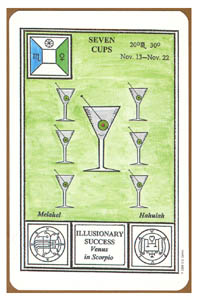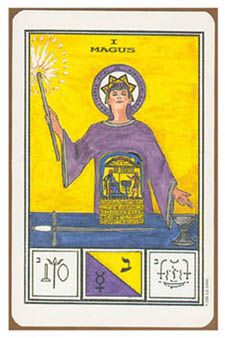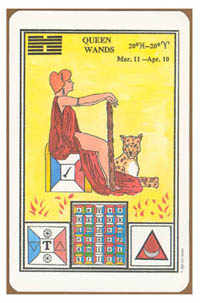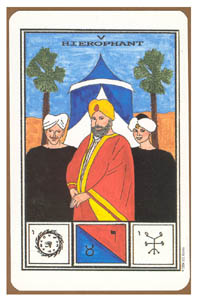|
 With Lon Milo DuQuette's "Tarot of Ceremonial Magick" we are back to the genuine tarot tradition; back to
what tarot was for years before the modern card reading craze began in the 1970s and the growing popularity
turned tarot into a mass medium. Apart from also being a card game, tarot was for about one hundred years,
beginning in the mid-19th century, essentially a tool for the practicing ceremonial magician. DuQuette is
one such with a great experience and in this deck he has combined the various systems that the magician
uses to obtain his goal: self-mastery, illumination and spiritual liberation. The deck is a natural sequel
to other genuine magick decks, like "The Golden Dawn Tarot" and Crowley's "Book of Thoth". DuQuette has
added more symbolic references than the preceding decks; apart from the known Hebrew and astrological
references, this deck also has references to the Enochian tablets, to the 72 spirits of Goetia and to the
Angels of Shemhamphorash. The Astrology references are extended to refer to the decanates. References to
the Tattwas and the I-Ching hexagrams are also included. What more can you expect? The tiny booklet gives
only a short survey over these complicated symbol systems, but a more extended study can be found in the
same author's "Tarot of Ceremonial Magick" (Weiser 1995), see below. The prototypes for the majors are
rendered and described in Duquette/Hyatt's The Way of the Secret Lover (Falcon 1991).
With Lon Milo DuQuette's "Tarot of Ceremonial Magick" we are back to the genuine tarot tradition; back to
what tarot was for years before the modern card reading craze began in the 1970s and the growing popularity
turned tarot into a mass medium. Apart from also being a card game, tarot was for about one hundred years,
beginning in the mid-19th century, essentially a tool for the practicing ceremonial magician. DuQuette is
one such with a great experience and in this deck he has combined the various systems that the magician
uses to obtain his goal: self-mastery, illumination and spiritual liberation. The deck is a natural sequel
to other genuine magick decks, like "The Golden Dawn Tarot" and Crowley's "Book of Thoth". DuQuette has
added more symbolic references than the preceding decks; apart from the known Hebrew and astrological
references, this deck also has references to the Enochian tablets, to the 72 spirits of Goetia and to the
Angels of Shemhamphorash. The Astrology references are extended to refer to the decanates. References to
the Tattwas and the I-Ching hexagrams are also included. What more can you expect? The tiny booklet gives
only a short survey over these complicated symbol systems, but a more extended study can be found in the
same author's "Tarot of Ceremonial Magick" (Weiser 1995), see below. The prototypes for the majors are
rendered and described in Duquette/Hyatt's The Way of the Secret Lover (Falcon 1991).
 DuQuette's magic is based on Crowley, and it is therefore not surprising the we find a portrait of the
young Crowley as The Magician. The artwork of the deck is rather amateurish, particularly the
uneven background colors are disturbing. It takes a lot of practice to color in a plain surface using
water colors or felt-pen! In this case it is, however, the symbolic contents that counts and nothing is
wrong with that.
DuQuette's magic is based on Crowley, and it is therefore not surprising the we find a portrait of the
young Crowley as The Magician. The artwork of the deck is rather amateurish, particularly the
uneven background colors are disturbing. It takes a lot of practice to color in a plain surface using
water colors or felt-pen! In this case it is, however, the symbolic contents that counts and nothing is
wrong with that.
 The deck is of the usual excellent US Games standard: well printed, good card stock, simple fitting cases.
The deck is of the usual excellent US Games standard: well printed, good card stock, simple fitting cases.
Ceremonial Magick, a guidebook
This book is just as necessary to obtain a good benefit from Lon Milo DuQuette's "Tarot of Ceremonial
Magick "as is Brian Williams' book is for "The Renaissance Tarot". DuQuette's tarot, which was reviewed
in Manteia #15 (above), is one of the few modern decks with genuine magickal reference incorporated in
the design. Unless one is a very trained ceremonial magician, a reasonable profit can only be obtained
of this deck when it is studied with this book now published by Weiser. This is again one of the mysteries
in the world of tarot publication. Why does this deck not come packed with the indispensable book? Why is
this book published by Weiser and not by US Games Systems, who otherwise frequently publishes accompanying
books?
 DuQuette's "Tarot of Ceremonical Magic" (the book) is an excellent survey of the classical tarot
correspondences, which nowadays in general are repressed by the numer and a book that, with no other
remedies and literature needed, allows you, if you care to spend the time needed, to delve into symbolic
systems like Kabbalah, Astrology, Enochian Magic and Goetia, which are what originally made tarot a
profound esoteric system, But it takes a lot more time and effort than to just become a practicing
intuitive tarot reader.
DuQuette's "Tarot of Ceremonical Magic" (the book) is an excellent survey of the classical tarot
correspondences, which nowadays in general are repressed by the numer and a book that, with no other
remedies and literature needed, allows you, if you care to spend the time needed, to delve into symbolic
systems like Kabbalah, Astrology, Enochian Magic and Goetia, which are what originally made tarot a
profound esoteric system, But it takes a lot more time and effort than to just become a practicing
intuitive tarot reader.
|